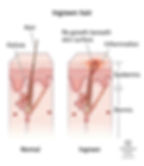Razor Bumps: Causes, Prevention, and Effective Treatment Strategies
- Hayden Hamil
- Jul 10
- 4 min read
Razor bumps, also known as ingrown hairs, can be incredibly frustrating for anyone who regularly shaves or grooms body hair. They occur when cut hair strands get stuck under the skin as they attempt to regrow, leading to inflammation, redness/hyperpigmentation, and even infection in some cases. Let us look at the causes, and possible preventative measures, as well as some effective treatment strategies, that individuals can use to manage this annoying condition more effectively.
What Are Razor Bumps?
Razor bumps are small, raised bumps on the skin that occur when cut hair gets stuck under the skin, but continues to grow, curling back on itself, rather than outward. They can show up anywhere hair is shaved, including the face, neck, armpits, legs, and bikini line. These bumps can be red on lighter skin tones, or hyperpigmented on darker skin tones. They may be itchy and, at times, appear pus-filled, which may complicate their identification.

Ingrown hairs can happen to anyone and most people will experience at least one in their lifetime. However, persons with thicker or curly hair are more prone to getting ingrown hairs. People who shave or wax frequently, especially in common areas like the face or pubic region are also at an increased risk of developing razor bumps, because the hair follicles often become blocked with oil, dead skin, or other debris.
Causes of Razor Bumps
Identifying the root (pun intended) causes of razor bumps is crucial for effective management and prevention. Key contributing factors include:
Curly Hair Types: Individuals with curly or coarse hair are at greater risk for developing razor bumps. These hair types are more likely to curl back into the skin after shaving.
Improper Shaving Techniques: Shaving against the direction of hair growth can lead to increased irritation, making razor bumps more likely. Research shows that those who follow proper shaving techniques have a 30% lower incidence of ingrown hairs.
Dull Blades: Using a dull razor can tug at the hair instead of cutting it cleanly. A sharp blade is essential for reducing the risk of ingrown hairs.
Sensitive Skin: People with sensitive skin are more prone to irritation and inflammation and the swelling can temporarily close or narrow the pore trapping the hair and thus increasing their susceptibility to developing razor bumps.
Lack of Exfoliation: Not exfoliating can result in a buildup of dead skin cells. Regular exfoliation can decrease the occurrence of razor bumps by up to 25%.
Prevention Strategies
Preventing razor bumps is often more effective than treating them after they occur. Here are some strategies to consider:
Choose the Right Razor
Select a sharp, clean razor designed for sensitive skin. Safety razors or electric shavers are excellent without adding irritation. Using a quality razor can reduce the chances of developing razor bumps significantly.
Shave in the Right Direction
Always shave in the direction of hair growth. This technique helps to ensure a cleaner cut and less risk of hair curling back into the skin.
Prepare the Skin Properly
Before shaving, it is essential to prepare the skin adequately. Use warm water to wash the area and apply a gentle, moisturizing shaving cream or gel. This can soften both hair and skin, making shaving smoother.
Exfoliate Regularly
Establish a consistent exfoliation routine. Exfoliating a day or two before shaving can remove dead skin cells and significantly lessen the incidence of razor bumps.
Moisturize After Shaving
Post-shaving, apply a soothing and non-comedogenic moisturizer to calm irritated skin and prevent blockage. Doing so can decrease inflammation by nearly 40%.
Effective Treatment Strategies
Even with preventative measures in place, razor bumps may still occur. Here are several effective treatment methods for existing bumps:
Warm Compress
Applying a warm compress to the affected area can help reduce inflammation and enhance blood circulation, potentially encouraging the ingrown hair to surface.
Use of Salicylic Acid
Salicylic acid is a common ingredient known for treating acne and can also effectively treat razor bumps. It helps exfoliate the skin and reduces inflammation.
Over-the-Counter Creams
Topical treatments containing hydrocortisone may help diminish itching and swelling associated with razor bumps. Additionally, creams with benzoyl peroxide can be useful in treating infections.
Avoid Picking or Scratching
Though it may be tempting to pick at the bumps, doing so can worsen inflammation and lead to scarring. Resist the urge; allowing your skin to heal naturally is best.
Seek Professional Care
If razor bumps are persistently painful, infected, or do not improve with over-the-counter treatments, consider consulting a dermatologist. They can offer more potent treatments and curated advice to prevent significant scarring.

Final Thoughts
Razor bumps may be a common issue, but understanding their causes and implementing effective prevention and treatment strategies can help minimize their occurrence. From selecting the right shaving techniques to consulting professional care when necessary, individuals can enjoy smoother skin and a more comfortable shaving experience.
If your bumps persist or worsen, reach out to a medical professional for tailored advice. With better grooming habits and a focus on skin health, you can significantly improve your shaving routine.



